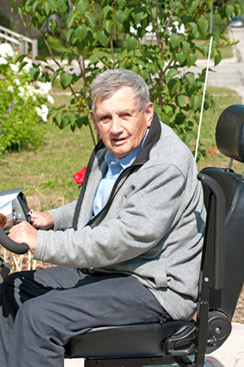Policies And Procedures Promote Safe Operation Of Scooters
Lisa Gluckstern
6/1/2012
Scooters and electric wheelchairs are used by slightly more than 5 percent of the assisted living population, according to the National Center for Health Statistics’ 2010 National Survey of Residential Care Facilities. While this may constitute a small number of residents, their use of scooters and wheelchairs is a complex issue to deal with because of two overlapping federal laws: the Americans with Disabilities Act and the Fair Housing Act.
From a risk management standpoint, developing policies and procedures regarding scooters requires balancing the resident’s need for the scooter with the safety of everyone else who enters the assisted living building, says Sheila Salisbury, an insurance specialist and consultant with RCM&D in Baltimore.
Salisbury has recently developed a policy for one of her clients—a continuing care retirement community—that can be adapted for assisted living buildings.

“The community had its fair share of accidents that resulted in damage to the building or injuries to other residents, visitors, and staff,” Salisbury says. “Since the policy was implemented there are still accidents, but the number and severity of accidents have decreased.”
She attributes the success to a policy that makes the entire community aware of the rules for the safe operation of motorized scooters or wheelchairs. Salisbury recommends that communities should present four handouts to residents who either have motor scooters or are about to get one.
The forms are Steps for Safely Acquiring and Operating an Electronic Motorized Vehicle (EMV), Rules of the Road, Safety and Enforcement, and Receipt of EMV Policy Handouts.
Salisbury recommends that someone other than the administrator be designated the EMV staff point person. This person will spend time with residents, explaining the policies and procedures contained in the forms. Salisbury advises suggesting to residents that EMVs should not exceed the federal guideline for a common wheelchair—30 inches wide x 48 inches long. Vehicles larger than 30 inches wide may prohibit safe operation in hallways and cannot be safely transported on community shuttles. If the resident already has an EMV, review all of the policies with the person, pointing out safety features.
Steps For Safely Acquiring And Operating Policy
1. Suggest residents meet with their primary care physicians so the physician can give the resident advice on what type of motorized vehicle best meets the resident’s needs. In addition, a physician’s examination and recommendation is required by Medicare to cover the costs of the EMV.
2. Ask a local medical center to recommend a vendor who can provide good service and value to the resident. Functionality of the EMV should be the most important consideration in choosing a model.
3. A staff person should review the Rules of the Road for safe operation with the resident.
4. Require residents to complete a registration form, and keep the form on file.
 Form Three: Safety and Enforcement of EMVs
Form Three: Safety and Enforcement of EMVs
Explain that the EMV staff point person will issue warnings to any EMV operator who is in violation of the rules of the road. If a complaint is filed, the community should keep the complaint confidential, then investigate to determine who is at fault. If no one is at fault, then no further action is necessary. If the operator is at fault, the operator will be issued a warning.
Enforcement/Warning Process
The enforcement process follows three violations. All violations should be issued to the EMV operator in writing.
On the second warning, include all of the steps included in the first warning and add that a third violation within 12 months may result in more serious consequences, such as a $50 service fee. Follow the first two phases and then submit the case to the community’s EMV Safety Review Board. The board will review past violations with the resident and make a determination as to whether operating privileges should be suspended or an exception granted.
Acknowledgement of Receipt and Review By Resident
This form should have the resident’s signature acknowledging receipt and that staff had reviewed the handouts for the safe operation of EMVs with the resident.